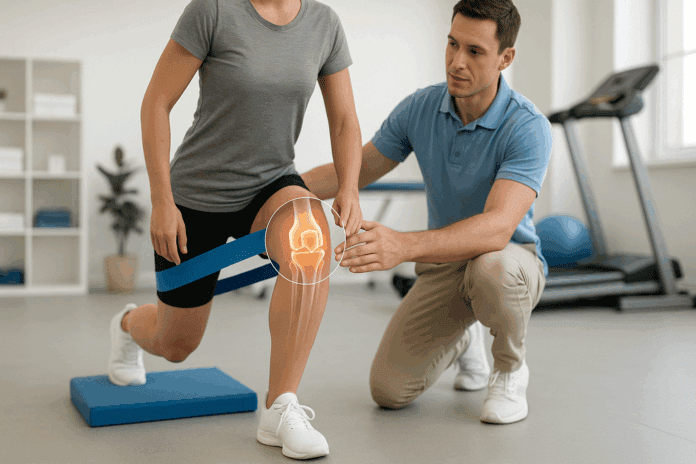Anterior knee pain is a common condition affecting a wide range of individuals, from elite athletes to sedentary office workers. It often presents as discomfort or aching at the front of the knee, typically around or behind the kneecap. While anterior knee pain can arise from various underlying causes, including overuse, muscle imbalances, and poor biomechanics, its impact on daily function can be profound. Fortunately, targeted exercise interventions have been shown to alleviate symptoms, restore functional movement, and reduce the likelihood of recurrence. This article explores the best anterior knee pain exercises that can be performed safely and effectively, grounded in the principles of musculoskeletal rehabilitation and supported by current evidence.
You may also like : Best Stretches for Sore Legs and Tight Thigh Muscles: How to Relieve Upper Leg Pain Safely and Naturally

Understanding Anterior Knee Pain and Its Underlying Causes
Anterior knee pain, also known in clinical settings as patellofemoral pain syndrome (PFPS), is characterized by pain originating from the contact between the posterior surface of the patella and the femur. It is a multifactorial condition, meaning that its onset and persistence can be influenced by a combination of biomechanical, muscular, and structural factors. For example, excessive pronation of the feet, decreased strength in the hip abductors, or tight quadriceps can all contribute to altered patellar tracking, increasing pressure on the joint and resulting in discomfort.
In athletic populations, anterior knee pain syndrome exercises are commonly prescribed to address both the symptoms and the mechanical contributors. However, it is not limited to athletes. Office workers, adolescents undergoing growth spurts, and individuals with poor posture or weak core musculature may also be susceptible. Regardless of the root cause, a comprehensive rehabilitation strategy incorporating anterior knee pain exercises is a cornerstone of treatment.
The Impact of Movement Screening and Functional Assessment
One of the most promising developments in orthopedic rehabilitation is the use of functional movement assessments to identify biomechanical inefficiencies that may contribute to anterior knee pain. Tools such as the Functional Movement Screen (FMS) and Y Balance Test allow clinicians and fitness professionals to evaluate dynamic stability, joint mobility, and asymmetries. These assessments can pinpoint specific movement faults, such as knee valgus during squatting or landing, which often correlate with poor patellar tracking.
Corrective exercises tailored to the results of such screenings can significantly improve outcomes. For example, if an individual demonstrates weakness in the deep hip external rotators during a single-leg squat, exercises targeting these muscles can be integrated into a personalized program. By using movement screening as a diagnostic tool, anterior knee pain syndrome exercises can be refined to target precise deficits, rather than relying solely on generalized protocols.
Emerging Role of Blood Flow Restriction (BFR) Training
Blood flow restriction (BFR) training has garnered increasing attention in recent years as a novel way to stimulate muscular hypertrophy and strength gains using low-load resistance exercises. By applying external pressure to the proximal portion of the limb with a specialized cuff, BFR training reduces venous return while allowing arterial flow, thereby creating a hypoxic environment that triggers muscle adaptation at significantly lower intensities.
For individuals with anterior knee pain who may not tolerate high-load resistance training, BFR presents a promising alternative. Research has demonstrated that combining BFR with quadriceps-specific exercises such as leg extensions or straight leg raises can promote strength gains without exacerbating joint pain. This method is particularly beneficial in the early stages of rehabilitation when joint tolerance is limited. As a complement to traditional anterior knee pain exercises, BFR can accelerate muscle recovery while minimizing mechanical stress on the knee.

Incorporating Aquatic Therapy for Low-Impact Strengthening
Aquatic therapy, or hydrotherapy, offers a unique environment for rehabilitation, particularly for individuals who experience high levels of discomfort with land-based activity. The buoyancy of water reduces joint loading, while the resistance provided by water supports muscle strengthening and cardiovascular conditioning. This approach is especially beneficial for older adults, post-operative patients, or individuals with significant biomechanical impairments.
Pool-based anterior knee pain exercises can include variations of squats, leg lifts, walking drills, and balance training. Water turbulence also introduces an element of proprioceptive challenge, which can aid in restoring joint position sense and neuromuscular coordination. As symptoms improve, patients can transition from aquatic to land-based training with greater confidence and less risk of flare-up.
Why Exercise Is Essential for Managing Anterior Knee Pain
While rest and anti-inflammatory strategies may provide short-term relief, long-term resolution of anterior knee pain hinges on addressing the root causes through movement and muscle re-education. Exercise serves not only to strengthen weakened musculature but also to improve neuromuscular coordination and joint alignment. The targeted use of anterior knee pain syndrome exercises can lead to significant reductions in pain severity, particularly when integrated with flexibility work, motor control training, and gradual reintroduction to activity.
Scientific literature consistently supports the use of structured rehabilitation protocols to manage patellofemoral disorders. For instance, strengthening the hip abductors and external rotators has been shown to positively influence knee kinematics. Similarly, closed-chain movements that promote co-contraction of the quadriceps and hamstrings offer a more stable environment for the knee joint, reducing the forces that exacerbate pain. As such, anterior knee pain exercises must be chosen carefully to support healing and prevent aggravation.
Nutritional Considerations for Supporting Knee Joint Health
Although exercise remains the cornerstone of anterior knee pain rehabilitation, nutrition plays a critical supporting role in joint health and tissue recovery. Chronic inflammation can exacerbate pain and slow healing, making it important to include anti-inflammatory foods in the diet. Omega-3 fatty acids, found in fatty fish, walnuts, and flaxseeds, are well-known for their inflammation-modulating properties.
Additionally, micronutrients such as vitamin D, calcium, and magnesium are vital for bone and muscle function. Collagen supplements and gelatin-based formulations, especially when paired with vitamin C, have also shown promise in promoting tendon and ligament integrity. While dietary changes alone are unlikely to resolve anterior knee pain, a well-balanced nutritional strategy enhances the body’s capacity to heal and adapt to stress imposed by anterior knee pain syndrome exercises.
The Psychological Component of Chronic Knee Pain
Pain perception is not solely a function of tissue damage; it is also influenced by psychological, emotional, and contextual factors. Individuals with chronic anterior knee pain may develop fear-avoidance behaviors, whereby they limit movement due to fear of exacerbating pain. Over time, this can lead to deconditioning, increased disability, and even central sensitization, in which the nervous system becomes more sensitive to pain signals.
Incorporating cognitive-behavioral strategies into rehabilitation may help address these issues. Encouraging gradual exposure to activity, setting achievable goals, and providing education about pain science can reduce anxiety and improve outcomes. Motivational interviewing and positive reinforcement are also useful tools for promoting adherence to anterior knee pain exercises. Addressing the psychological dimension ensures a more holistic and sustainable recovery.
Understanding Foot Mechanics and Orthotic Interventions
Poor foot mechanics can have a cascading effect on the entire kinetic chain, often contributing to anterior knee pain through altered lower limb alignment. Overpronation, in particular, leads to increased tibial internal rotation, which can disrupt patellofemoral tracking. Assessing foot posture and gait patterns is therefore essential for a comprehensive intervention.
Orthotic devices, whether custom-made or over-the-counter, can help correct excessive pronation and provide improved arch support. When used in conjunction with anterior knee pain syndrome exercises, orthotics can enhance movement quality and reduce compensatory stress on the knee. Footwear selection is equally important; shoes with adequate cushioning and structural support can minimize impact forces during daily activities and exercise.
Environmental and Ergonomic Adjustments to Reduce Strain
The physical environments in which we live and work can either support or hinder musculoskeletal health. For individuals dealing with anterior knee pain, long periods of sitting in poorly designed chairs or climbing steep stairs frequently may aggravate symptoms. Making ergonomic adjustments, such as using a chair with appropriate lumbar and thigh support, or installing railings for stair use, can make a significant difference.
At home and in the workplace, incorporating standing desks, using kneeling chairs, or performing regular movement breaks can reduce the cumulative load on the knees. Simple adaptations to reduce unnecessary joint stress can prevent flare-ups and support consistent progress with anterior knee pain syndrome exercises. Environmental awareness and strategic design can be valuable allies in long-term pain management.
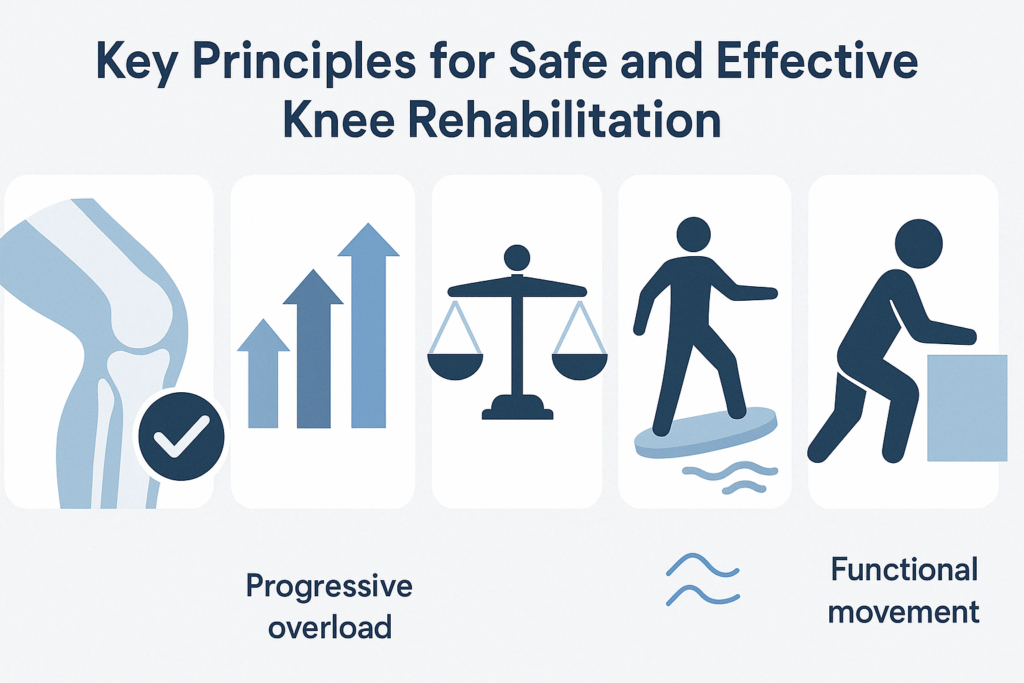
Key Principles for Safe and Effective Knee Rehabilitation
When developing a rehabilitation plan for anterior knee pain, several guiding principles should be adhered to. First, exercises should be pain-free or minimally provocative during execution. Discomfort during movement can lead to compensatory strategies that hinder progress or cause injury elsewhere. Second, progressive overload should be applied cautiously. While strengthening is a key goal, overly aggressive progression can lead to flare-ups and diminished compliance.
Equally important is the concept of neuromuscular control. Improving the ability of the nervous system to coordinate movement patterns can have a protective effect on the knee. Incorporating proprioceptive and balance training helps individuals regain control over their movement and stabilize the joint under dynamic conditions. Lastly, exercises should be functional. That is, they should mimic the demands of daily life or sport, thereby improving the carryover of rehabilitation gains to real-world activities.

The Role of Hip Strength in Knee Health
One of the most overlooked contributors to anterior knee pain is weakness in the hip musculature. The gluteus medius and gluteus maximus, in particular, play a vital role in stabilizing the pelvis and controlling the position of the femur during movement. Weakness in these muscles often results in increased internal rotation and adduction of the femur, which can alter patellar tracking and increase stress on the knee joint.
Targeted strengthening of the hip can yield profound benefits. Clamshells, side-lying leg raises, and monster walks with resistance bands are all commonly prescribed anterior knee pain syndrome exercises that directly address hip dysfunction. Clinical studies have demonstrated that incorporating hip strengthening into a rehabilitation program leads to faster resolution of symptoms compared to quadriceps-focused training alone. Thus, no anterior knee pain exercise program should neglect the proximal contributors to knee stability.
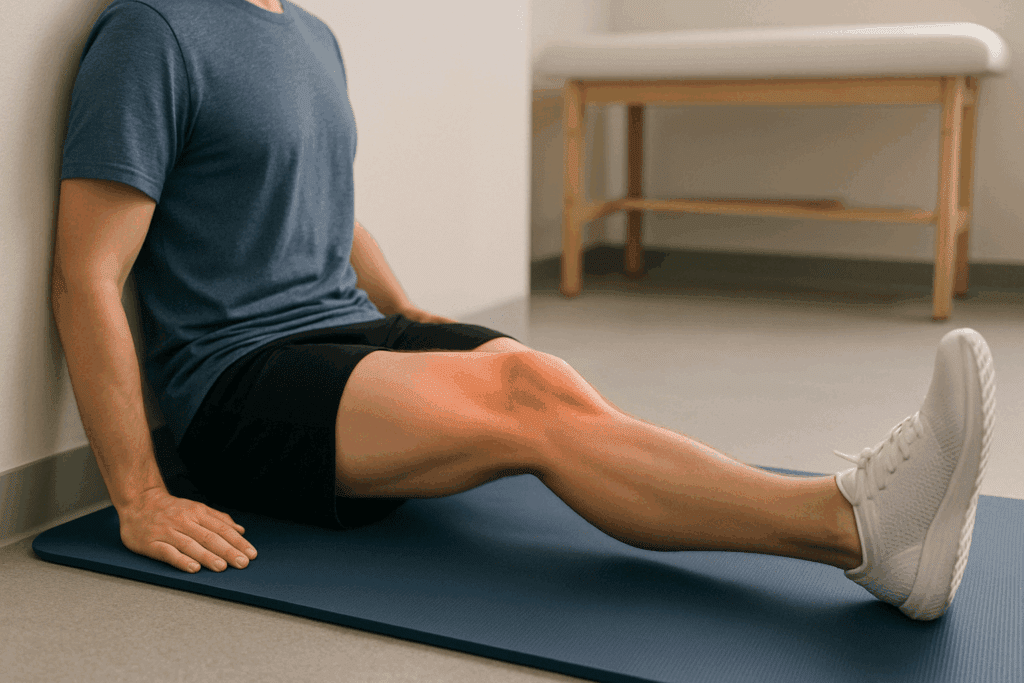
Quadriceps Activation and Strengthening Strategies
The quadriceps muscle group, comprising the vastus medialis, vastus lateralis, vastus intermedius, and rectus femoris, is integral to knee extension and patellar tracking. Weakness or delayed activation, especially of the vastus medialis oblique (VMO), has long been associated with anterior knee pain. Strengthening the quadriceps is therefore a central component of most therapeutic protocols.
However, not all quadriceps exercises are created equal. Isometric contractions, such as quad sets and straight leg raises, are excellent starting points, particularly in the early phases of rehabilitation when dynamic loading may be too painful. As symptoms abate, progression to closed-chain movements such as wall sits, step-ups, and mini squats is encouraged. These anterior knee pain exercises help engage the quadriceps in a functional manner while minimizing patellar stress. Special attention should be paid to form and alignment to ensure safe execution and optimal benefit.
Hamstring and Calf Engagement to Support Knee Mechanics
Although the quadriceps receive much of the focus in knee rehabilitation, the hamstrings and calf muscles also play a significant role in maintaining knee health. The hamstrings act as antagonists to the quadriceps, providing posterior support to the knee and controlling forward tibial translation. Meanwhile, the gastrocnemius and soleus muscles contribute to knee flexion and overall lower limb stability.
Incorporating eccentric hamstring exercises, such as Nordic curls and Romanian deadlifts, can enhance posterior chain strength and improve knee function. For the calves, heel raises and toe walks help promote dynamic balance and coordination. These exercises not only bolster support around the knee but also address biomechanical deficits that often accompany anterior knee pain. A well-rounded program that includes these elements tends to be more effective and sustainable.
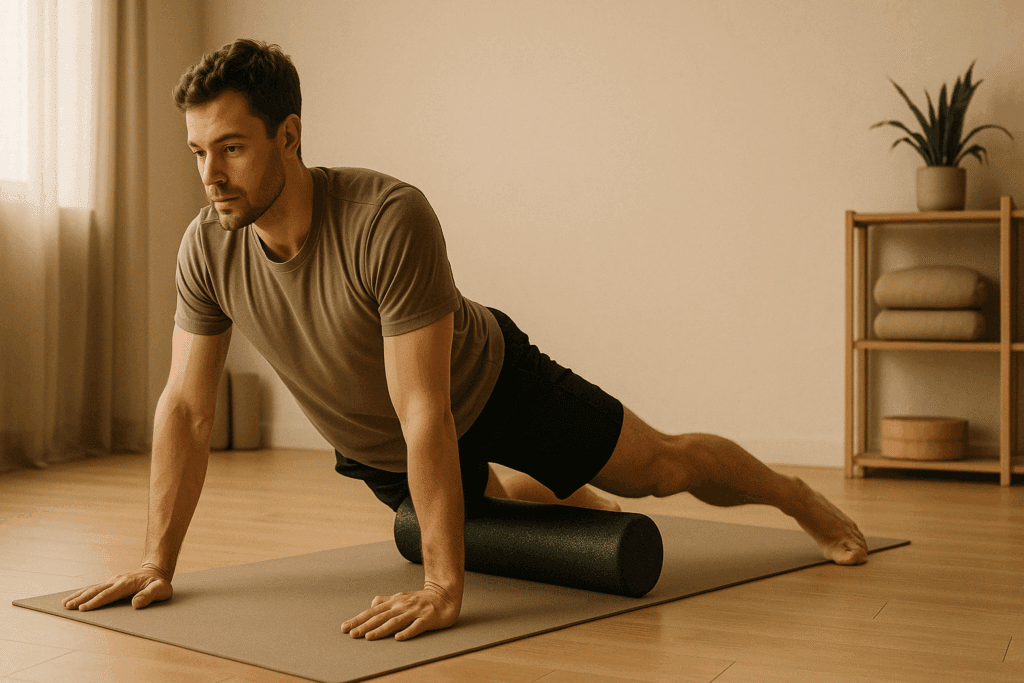
Stretching and Mobility Work to Address Muscle Tightness
Tightness in certain muscle groups—particularly the quadriceps, iliotibial (IT) band, and hip flexors—can exacerbate anterior knee pain by contributing to altered patellar tracking and increased joint stress. Therefore, mobility work should be an integral part of any rehabilitation protocol. Dynamic and static stretching techniques can be employed to target these areas and restore normal tissue extensibility.
Foam rolling, myofascial release, and guided mobility drills are all effective methods to improve flexibility and reduce tension. For instance, stretching the rectus femoris, a biarticular muscle that crosses both the hip and knee, can significantly decrease strain on the patellofemoral joint. Incorporating these strategies into a comprehensive routine helps to ensure that strengthening efforts are not undermined by restrictions in mobility. Such integration elevates the effectiveness of anterior knee pain exercises and supports long-term joint health.
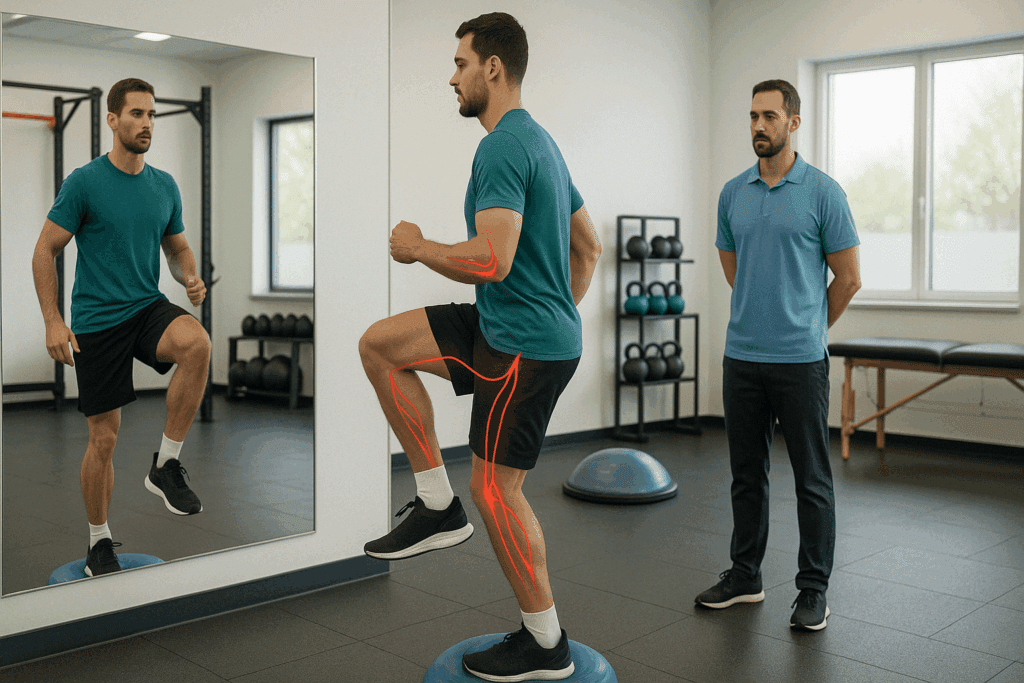
Proprioceptive and Balance Training for Joint Stability
Proprioception refers to the body’s ability to sense its position in space and adjust movements accordingly. It is critical for joint stability and coordination, particularly following injury or in the presence of chronic pain. Anterior knee pain can impair proprioceptive feedback, increasing the risk of instability and re-injury. To counteract this, balance training and sensorimotor exercises should be incorporated into rehabilitation.
Single-leg stands, Bosu ball exercises, and dynamic reaching tasks challenge the neuromuscular system and improve the body’s capacity to respond to unexpected stimuli. These exercises may begin on stable surfaces and progress to more unstable conditions as control improves. In doing so, individuals enhance their functional movement capabilities and reduce reliance on compensatory strategies. Integrating proprioceptive training into anterior knee pain syndrome exercises not only accelerates recovery but also helps future-proof the knee against new injuries.
Modifying Daily Activities to Support Recovery
While structured rehabilitation exercises are essential, modifying daily habits and activities plays a crucial role in managing anterior knee pain. Poor posture, improper footwear, and prolonged sitting can all place unnecessary strain on the knees. For example, sitting with the knees in deep flexion for extended periods can increase intra-articular pressure and worsen symptoms.
Small adjustments, such as using ergonomic seating, elevating the legs when resting, and choosing supportive shoes, can make a significant difference. Additionally, individuals should be encouraged to gradually resume physical activities rather than abruptly returning to high-impact exercise. Understanding how to move and live in a way that protects the knees is just as important as performing specific anterior knee pain exercises. These behavioral changes enhance the overall effectiveness of the rehabilitation process.
When to Seek Professional Guidance
Although many cases of anterior knee pain can be managed successfully with self-guided rehabilitation, there are circumstances that warrant professional intervention. Persistent or worsening pain, episodes of instability, swelling, or mechanical symptoms such as locking or catching should prompt consultation with a healthcare provider. A thorough physical assessment can identify structural issues such as cartilage damage, meniscal injury, or patellar malalignment that may not respond to exercise alone.
Physical therapists, orthopedic specialists, and sports medicine practitioners can provide individualized treatment plans and ensure exercises are performed safely. In some cases, adjunctive treatments such as taping, bracing, or manual therapy may be necessary to facilitate recovery. Understanding the limits of self-care and knowing when to seek help are important components of responsible rehabilitation and long-term joint health.
Long-Term Maintenance and Prevention Strategies
Once symptoms have improved and functional capacity is restored, the focus shifts to maintaining gains and preventing recurrence. This involves continuing with a modified version of the exercise routine, paying close attention to any return of discomfort, and making lifestyle choices that support knee health. Regular participation in physical activity that includes strength training, mobility work, and cardiovascular conditioning helps keep the musculoskeletal system resilient.
Monitoring movement patterns during sports and exercise is also critical. Poor biomechanics, such as knee valgus during squatting or landing, can predispose individuals to reinjury. Video analysis, feedback from coaches or therapists, and self-assessment tools can aid in maintaining proper technique. Preventative anterior knee pain syndrome exercises should be viewed not as a temporary fix but as a lifelong investment in joint health and mobility.
Rehabilitation Timelines and Realistic Expectations
One of the most important aspects of managing anterior knee pain is setting realistic expectations for recovery. Unlike acute injuries, chronic knee pain often requires weeks or even months of consistent effort to achieve meaningful results. Progress may not always be linear, and flare-ups can occur even with adherence to exercise protocols.
Educating individuals on the typical timeline of musculoskeletal adaptation—such as the four-to-six-week window for initial strength gains or the eight-to-twelve-week period for structural changes—can help manage expectations and sustain motivation. Clear communication about the purpose and expected outcomes of anterior knee pain exercises fosters trust and empowers individuals to take an active role in their recovery.
Frequently Asked Questions (FAQ): Anterior Knee Pain Exercise Strategies
1. What should I do if anterior knee pain worsens after starting an exercise program?
If your anterior knee pain intensifies after initiating a new exercise routine, it may be a sign that you’re overloading the joint or performing certain movements with suboptimal form. In such cases, it’s advisable to temporarily reduce the intensity and reassess the exercises you’re using. Anterior knee pain exercises should be progressive but not painful; modifying depth in squats or switching from open-chain to closed-chain activities can ease discomfort. Consulting a physical therapist can help you identify movement patterns that may be aggravating your knee, such as excessive internal femoral rotation or anterior pelvic tilt. Importantly, anterior knee pain syndrome exercises need to be adapted to individual biomechanics—what works for one person might not suit another.
2. Can anterior knee pain syndrome exercises help with pain related to previous knee surgeries?
Yes, anterior knee pain syndrome exercises can be beneficial for individuals experiencing pain after knee surgery, especially procedures involving the patella, meniscus, or cartilage. Post-surgical discomfort often stems from residual weakness, scar tissue, or altered movement mechanics. Exercises that focus on neuromuscular re-education, such as step-downs, resistance band glute bridges, or dynamic balance drills, can be especially helpful. These targeted movements help restore coordinated strength and improve tissue resilience around the surgical site. However, surgical cases should be approached cautiously; a supervised rehabilitation program ensures anterior knee pain exercises are implemented safely and in a phase-appropriate manner.
3. How does footwear affect the success of anterior knee pain exercises?
Footwear plays a critical role in knee biomechanics, influencing how ground forces are absorbed and transmitted through the lower limb. Worn-out or unsupportive shoes can exacerbate misalignments, reducing the effectiveness of even the most well-designed anterior knee pain exercises. Shoes with proper arch support and cushioning help maintain optimal alignment during movement, reducing stress on the patellofemoral joint. This is particularly true during activities like walking lunges or step-ups, where instability at the foot level can propagate upward and alter knee mechanics. For individuals incorporating anterior knee pain syndrome exercises into daily life, investing in high-quality footwear—or using custom orthotics when necessary—can significantly enhance outcomes.
4. Are anterior knee pain exercises safe for older adults with osteoporosis or arthritis?
With the right modifications, anterior knee pain exercises can be both safe and effective for older adults managing conditions like osteoporosis or arthritis. The key is selecting low-impact movements that minimize joint compression while promoting strength and mobility. For instance, partial chair squats, wall-assisted sit-to-stands, and aquatic resistance training are all appropriate and protective of fragile joints. It’s also important to avoid abrupt, deep knee flexion or high-impact jumping. When adapted thoughtfully, anterior knee pain syndrome exercises can help maintain function, reduce stiffness, and improve balance in older adults without exacerbating degenerative changes.
5. Can anterior knee pain exercises be used preventively in athletic populations?
Absolutely. Anterior knee pain exercises are not just therapeutic—they’re also preventive. Athletes, especially runners and jumpers, often place high loads on the patellofemoral joint, making them susceptible to overuse injuries. Incorporating anterior knee pain syndrome exercises like eccentric squats, lateral band walks, and proprioceptive drills into their regular training regimen can help build resilience in both the muscles and connective tissues. These exercises not only improve strength but also enhance motor control, reducing the likelihood of faulty movement patterns during competition. Preventative use of such exercises can be a game-changer in reducing downtime due to injury.
6. Is it normal for anterior knee pain to fluctuate even with a consistent exercise plan?
Fluctuating symptoms are common during the rehabilitation process and do not necessarily indicate failure. Several factors can influence pain levels, including sleep quality, inflammation, stress, and daily activity choices. Even when anterior knee pain exercises are performed correctly, small setbacks may occur due to external stressors or overtraining. Instead of discontinuing exercise altogether, it may be beneficial to scale back for a few days, focus on gentle mobility work, and ensure adequate recovery. In fact, integrating active rest periods and deload weeks can make anterior knee pain syndrome exercises more sustainable over time.
7. What role do the hamstrings play in anterior knee pain syndrome exercises?
Although anterior knee pain primarily affects the front of the knee, the hamstrings are integral to its management. These muscles provide posterior support to the tibia, balancing the pull from the quadriceps and reducing forward shear forces on the knee. Anterior knee pain exercises that include hamstring strengthening, such as glute bridges, Swiss ball curls, or deadlifts, can improve joint stability and help correct muscle imbalances. Neglecting the posterior chain often leads to overcompensation from the quadriceps, potentially worsening patellar tracking. Including the hamstrings in anterior knee pain syndrome exercises creates a more balanced, joint-protective strategy.
8. How can someone monitor progress when doing anterior knee pain exercises at home?
Monitoring progress can be done in both subjective and objective ways. Subjectively, individuals can track changes in pain during daily activities—such as stair climbing, standing from a chair, or walking long distances. Objectively, keeping a log of how many reps and sets of anterior knee pain exercises you can complete without discomfort provides tangible feedback. Functional tests like the single-leg sit-to-stand or timed stair ascent can also be repeated every few weeks to assess improvement. For those using anterior knee pain syndrome exercises independently, video recordings can help assess form and reveal subtle improvements in alignment or control.
9. Do stress and mental health impact the outcomes of anterior knee pain exercise programs?
Yes, mental health plays a powerful role in physical rehabilitation. Chronic anterior knee pain can contribute to emotional distress, which in turn amplifies pain perception and diminishes motivation to exercise. Incorporating mindfulness, guided breathing, or even light yoga into a rehab plan can help create a more holistic recovery environment. When patients understand how stress exacerbates muscle tension and joint sensitivity, they become more proactive in adopting coping strategies. Therefore, pairing anterior knee pain syndrome exercises with stress management tools can dramatically enhance overall outcomes and adherence.
10. What innovations are emerging in the treatment of chronic anterior knee pain?
Innovative approaches like neuromuscular electrical stimulation (NMES), real-time EMG biofeedback, and blood flow restriction (BFR) training are reshaping how clinicians address stubborn cases of knee pain. These technologies enhance muscle activation, increase engagement of underused stabilizers, and allow strength gains without high joint loads. For example, BFR combined with low-load anterior knee pain exercises can stimulate hypertrophy and vascular adaptations safely. Additionally, smart sensors and motion capture systems are making it easier for patients to receive real-time feedback on their technique during anterior knee pain syndrome exercises. As these tools become more accessible, they promise a more personalized and effective rehab experience for individuals managing chronic pain.
Conclusion: Reclaiming Knee Function with Safe and Effective Anterior Knee Pain Exercises
Anterior knee pain can be a frustrating and debilitating condition, but with the right approach, recovery is entirely achievable. By understanding the underlying causes and incorporating a balanced, evidence-based rehabilitation strategy, individuals can reduce discomfort and enhance their quality of life. The best anterior knee pain exercises focus on building strength, improving mobility, enhancing neuromuscular control, and addressing the root causes of dysfunction.
When these exercises are performed consistently and integrated into a broader lifestyle approach, they not only relieve symptoms but also empower individuals to take control of their joint health. Whether recovering from an acute episode or managing chronic anterior knee pain, a proactive and informed strategy is key. Through expert-guided rehabilitation and thoughtful self-care, it is possible to move confidently and pain-free again.
Was this article helpful? Don’t let it stop with you. Share it right now with someone who needs to see it—whether it’s a friend, a colleague, or your whole network. And if staying ahead on this topic matters to you, subscribe to this publication for the most up-to-date information. You’ll get the latest insights delivered straight to you—no searching, no missing out.
Further Reading:
The 18 Best Exercises for Knee Pain, According to a Physical Therapist
Effective Exercises for Knee Pain Relief
21 Best Knee Strengthening Exercises And Precautions To Take

